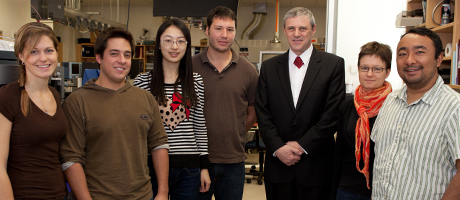The LAESI-DP 1000 Direct Ionization System, a commercial product based on an invention made at GW by Professor Akos Vertes and his research group, has received a 2012 R&D 100 Award, ranking it as one of the 100 most technologically significant products introduced in the past year. The yearly rankings are compiled by R&D Magazine.
Dr. Vertes and his team developed the Laser Ablation Electrospray Ionization (LAESI), technique, which allows researchers to more quickly and effectively learn the chemical composition of a biological sample. GW owns the patent on the technique and licensed it to Protea Biosciences Inc., which developed the commercial product.
“During the past 50 years, the R&D 100 Awards repeatedly identified technological game changers, including the fax machine and HDTV,” Dr. Vertes said. “It is humbling to see our technology listed in the company of these transformative inventions. LAESI fills a gap in the increasingly sophisticated instrumentation for life sciences by reporting on biomolecules produced during the actual functioning of an organism, organ, tissue or cell.”
Dr. Vertes, founder and co-director of GW’s W.M. Keck Institute for Proteomics Technology and Applications and a faculty member with the Columbian College of Arts and Sciences, developed an approach for identifying proteins, peptides, lipids, metabolites and other biomolecules directly from cells, tissues, biofluids and any other sample that contains water. The technology has the potential to support a broad range of applications in such fields as pharmaceutical and biological research, surgical and molecular pathology, clinical diagnostics, chemical and biological defense, forensics, agriculture and food process monitoring.
In 2008, Protea Biosciences entered into an exclusive, worldwide license agreement with GW for commercial rights to LAESI. The LAESI technology was brought to the marketplace through GW’s Office of Technology Transfer. OTT promotes and facilitates the transfer of GW innovations for the benefit of the university community and the public while leveraging GW resources through partnering with industry experts and entrepreneurs. The office acts as a bridge between in-house laboratory research and companies, entrepreneurs, and investors. Its primary aim is to connect university researchers with business enterprises, entrepreneurs, and unique external resources.
In January 2012, LAESI was recognized as a top innovation of 2011 by The Scientist, a British publication.


